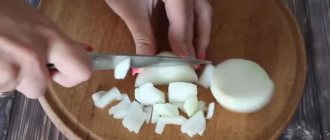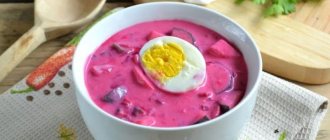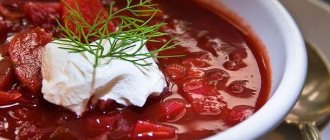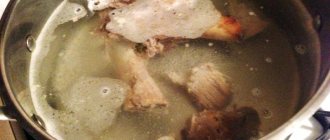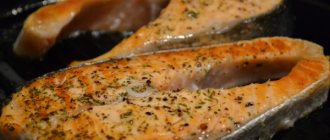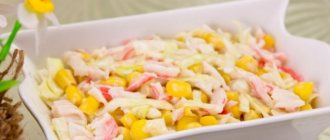There are such well-loved dishes, even the names of which evoke wild hunger, and borscht precisely belongs to this category. The most delicious first course has become the standard of a real housewife. Deliciously prepared borscht can not only feed the whole family, but also guests. In some families, a pot of borscht is an integral part of the refrigerator, because this dish is incredibly tasty not only when eaten fresh. After standing in the refrigerator for a couple of days, the borscht becomes even tastier. Each housewife has her own recipe for borscht, which is passed down from mother to daughter, and she, in turn, complements and improves it to her taste.
Borscht philosophy
Now we’re not talking about whether you know how to cook borscht or not, let’s just get a little philosophical.
As paradoxical as it may sound, the main idea and power of this dish is that each spoon should taste different from the previous one. It’s not difficult to do this trick; just chop each vegetable larger so that their flavors don’t mix for as long as possible. It’s not surprising, because the components of a classic vinaigrette or Olivier are also prepared separately, and only then mixed.
There is no need to grate vegetables. Onions, beets and carrots must be cut into strips, and always with a sharp knife. But this is all that is required to preserve the taste:
- Do not cook vegetables in broth for a long time.
- Pieces of carrots, onions and beets should be well soaked in oil so that they can repel the broth longer during cooking.
To be completely principled, borscht is the same soup, and the base of any soup is broth. Usually everything that is at hand is suitable for it, like for a meat hodgepodge. If the cook is worthy, he will prepare you borscht from anything, even from water.
Technology
It’s safe to say that the issue here is not the meat, not the quantity of certain vegetables, but solely the cooking technique. If you already know how to cook delicious homemade borscht, then you won’t argue with this fact. Briefly, the process flow looks like this:
- Cook broth or boil water.
- Add potatoes and let them cook.
- Cut the onion and carrots with a knife and fry them in oil.
- Chop the beets and simmer them in oil with tomato paste or fresh tomatoes. You can sprinkle the beets with vinegar.
- Chop the cabbage.
- Add prepared onions, carrots, and beets into the broth. Let them cook for 5-8 minutes until done.
- Add cabbage. After resuming boiling, cook for 3-5 minutes and remove from heat.
We could put an end to this here, but I would like to discuss a few more key moments of the borscht epic.
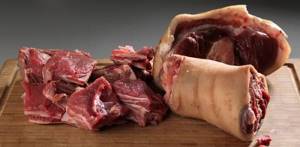
If you know how to prepare broth for borscht, then everything will work out
There are so many cooking options! In the culinary community, disputes over its preparation methods can be compared to heated political debates. But you and I are not going to discuss, we are simply learning how to cook borscht.
What will we make the broth from?
There is no need for expensive tenderloin here. But pork shank and beef ribs or backbone with ribs will be just right. Beef or lamb brisket will do, but not the pulp. If there is not enough meat on the plate, then take a good piece of veal and boil it briefly in the prepared broth. Then cut it into pieces and place on plates.
There are many opinions on how to prepare broth for ordinary borscht. Some prefer to cook it on duck or rooster, others prefer only pork, and still others even use sprat in tomato sauce. Well, who do you think is right? Yes, everything that anyone had was cooked from, and then it became a custom.
What kind of water do we put the meat in and when do we add salt to the broth?
A pig shank can be washed; no one knows where it was until it landed on the counter. Beef ribs, for example, do not need to be washed; it is enough to remove the film from them, and the inside is sterile.
You need to put the meat in cold water. I don't know about you, but I immediately add a quarter of the recipe amount of salt. This way the foam goes away faster, and large pieces of meat have time to salt well down to the bones.
But there is also an opinion that meat should be immersed in boiling water. Let me disagree with this, a piece of meat “for a plate” - yes, you can put it in a slightly gurgling broth. What happens to a cut of meat if it is burned with boiling water? The tissues easily shrink from the high temperature, the meat warps, and the juices are squeezed out of it.
Will borscht turn out delicious at home if you don’t skim off the foam?
Of course, it won’t work, you need to remove the foam, and carefully. Nobody says that you have to constantly stand over the broth. It formed - they removed it, it formed again - they removed it again. Otherwise, the vegetables will absorb all the foam, and this is a disgrace. A mesh slotted spoon will be just right here.
There is another technique - straining. Overall, it’s a good option, but it comes with certain inconveniences. For example, you need to take out all the meat and add new water. In short, this is all too troublesome for me.
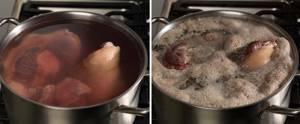
Some people prefer to drain the first water. I don’t know, one could agree with this if the broth is cooked on pork shanks. But, you see, how can you cook delicious homemade borscht if a lot of the good stuff goes out of the brisket ribs even before the first boil? And this is what you propose to drain? No way!
What should we add to the broth?
Absolutely the same as in the broth for any soup. This has already been said and discussed, which is inconvenient to remind, but still:
- Onions, carrots.
- Peppercorns and allspice.
- A few clove buds per bulb.
- Barney bouquet, a classic set consisting of bay leaf, fresh thyme and parsley. The list can be expanded - Google will help, as they say.
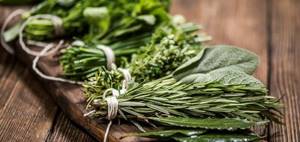
Notice how the broth is cooked. It practically does not boil, only gurgles slightly, releasing bubbles of steam no more often than the pulse on your hand. By adhering to this rule, you will get a clear and aromatic broth. When the broth is ready, remove all spices and vegetables.
In addition to onions and carrots, some people add celery root and parsley. But there are also those who do not add anything, believing that sautéing vegetables will be enough. I consider this opinion to be erroneous and a gross violation of the entire technology.
How to cook homemade borscht: what to take out and what to put in
There is no need to cook the meat for too long. After all, we cook the broth, which means we don’t need a high content of gelling substances, like in beef jellied meat. Therefore, we take it out, remove the meat from the bones, add a little salt and cover. That's all for now. By the way, when you take out the meat, you can strain the broth.
I would not recommend leaving the meat cut until the very end. If you want to cook delicious homemade borscht, remove the meat on time. No, if you want to definitely mix flavors and color the meat, then take a blender - this will give you an even wider range of flavors.
What to add to the finished broth, and in what order to do it
As a rule, it is at this stage that trouble happens. Some housewives are already managing to introduce sautéing; they probably want to completely discolor it. They add cabbage later - it crunches better. To prevent the sauté from losing its color, one cook advised adding vinegar. I’m not sure that such a measure will help, but if you strictly adhere to the order, the absence of problems is guaranteed:
- If you decide to use turnips, put them in the broth first, before the potatoes. By the way, you can do without potatoes, especially when you still have a good piece of meat boiled.
- Follow the potatoes with cabbage and only then the bell pepper. If you wish, you can throw in a spicy pod, but only in its entirety.
- When the borscht is about to be ready, it’s the turn of the bay leaf. You should never overcook it; in such broths, bay leaves are like tea leaves. The bay leaf should leave a light aroma, without any aftertaste.
- Add half the recipe portion of salt to the pan.
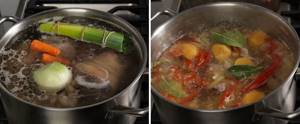
Cabbage question
It must be said right away - no graters, even the most beautiful ones. Just a sharp knife, and in small pieces, they won’t have to cook for long. Stem stalks, large leaves - away!
I met an amateur cook who uses sauerkraut to prepare borscht at home. In general, I agree with him, it’s a great solution, but only for a different dish. There are also comrades who add cabbage ahead of the rest of the vegetables, and there are also those who do not use cabbage at all. Apparently they mixed up the dishes.
Clarifications
The recipe for increasing the richness of borscht is simple: just replace the veal with pork. Good strong fat is produced by bones, preferably brain bones. Once the broth is cooked, they can be removed. To make the soup less fatty, take half a kilo of veal and the same amount of pork.
Spicy lovers add pepper to borscht. If you just need a light aroma, then use bell pepper. If spiciness is required, then hot pepper is suitable. The seeds and stalk are removed from the peppers, and then cut into strips. The slices are added to the borscht half an hour before it is ready. The most desperate ones use ground pepper. Take a pinch of black or red pepper for 1 serving. The latter is much sharper. You need to be very careful with both of them.
Vegetable oil can be replaced with lard. It is cut into small cubes and melted in a frying pan. The resulting greaves (thawed and darkened pieces of lard) are removed. Connoisseurs then add them to the soup.
If for one reason or another the recipe for homemade pasta cannot be executed, then you can cook the soup using purchased tomato paste.
In contact with
Do we know how to saute borscht?
I think you know the difference between sautéing and frying or stewing. If not, again, Google will help. As for the order:
- The onions are fried and sautéed.
- Then carrots.
- Then add tomatoes; if they have an unclear taste, you need to add a little tomato paste.
- Lastly, the beets are sautéed.
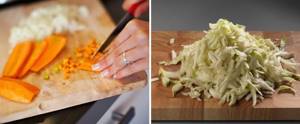
For some reason, some people fry onions and carrots separately, and tomatoes and beets separately. To be honest, I don’t see the point in an unnecessary operation. Well, maybe you have an extra frying pan and a desire to wash it later.
What to fry with
This is an important point, I think it all depends on the meat that was chosen for the broth, well, and the season. Let's say you don't cook the broth with beef brisket, but sauté it in melted butter. For what?
For sauteing you need to use good vegetable oil, this is important - good. You can easily dip a piece of bread in this butter and eat it. Let all sorts of super-duper-extra olive oils remain for glamorous chefs, and let us keep it simple.
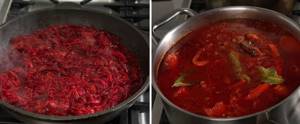
What else to add to homemade borscht after sauteing?
So, the sauteing and meat are already in the pan. All that remains is to take a sample and add salt if necessary. That's it - the wrestler is ready! But not everyone at this stage is, excuse me, lapidary. Who adds vinegar or lemon juice. Crushed garlic is also used, and in some places bran kvass is also used.
To be honest, I don’t quite understand such additives. Was it really impossible to get the necessary acid from tomatoes or sauerkraut? But mashed lard with garlic is another matter! And a little chopped parsley... and garlic donuts...
Isolda Solyankina
Classic borscht recipe:
Ingredients: for the broth: water - 1.5–2 l.; pork or cowhide on the brush - 400 g. For greasing: beet - 2 pcs. (small); carrots - 1 pc.; tsibulya - 3 pcs. (middle); tomato paste - 2 tbsp. l.; Sonyashnikova oliya - 4-5 tbsp. l.; citric acid - pinch. For borscht: fresh white cabbage - 300 g; potatoes - 4 pcs. (middle); salt, bay leaf, herbs - for relish. For serving: sour cream - 1 tbsp. l. (in a skin plate); greenery.
Preparation: Cook the broth - take a 3-liter saucepan. Pour 1.5–2 liters of water into it, add meat. Place it on the middle heat. Monitor the broth and remove the foam before boiling. The broth will be more delicious if you simmer the meat itself on the bone. When it comes to a boil, cover the pan with a lid and cook over low heat for one year and repeat.
Robimo fry - while the broth is boiling, brush the vegetables. Wash and peel the beet, carrots and cibul. Grate the beet into a large third, and the carrots into the middle. Cut the zibula into cubes. Pour the oil onto the pan, add medium heat. Lubricate the cabbage and carrots (5 khvilins), then add the beet. Brush the beet with citric acid or sprinkle with fresh lemon juice. Zavdyaki for this borscht will be in the truest red. Grease the vegetables with 5 more coats. After this, add tomato paste, mix and add another 5-7 minutes to the gas.
We collect the borscht - when the broth is boiling, remove the meat from it. While the meat is cooking, throw the shredded cabbage into the broth. After 5-10 minutes, add the diced potatoes. While the potatoes are cooking, add the meat to the brushes and cut into cubes. Turn the meat into the soup. Add salt for relish. Add lubricant. Stir. Add bay leaf and finely chopped greens. Cover the pan with a lid and cook for another 5-7 chickens. The borscht is ready.
Serving: borscht can be eaten immediately after cooking. Ale, as a rule, is even more delicious the next day. Pour the borscht into deep bowls. Add sour cream, fresh herbs, black pepper (if you like it hotter) and a slice of lemon (if you want it sour). Eat borscht with life bread or rich buns grated with chasnik.
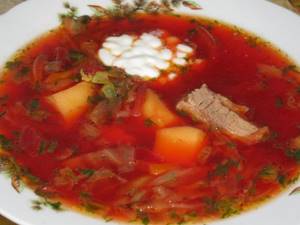
One of the most popular is Ukrainian borscht \ Wikipedia

